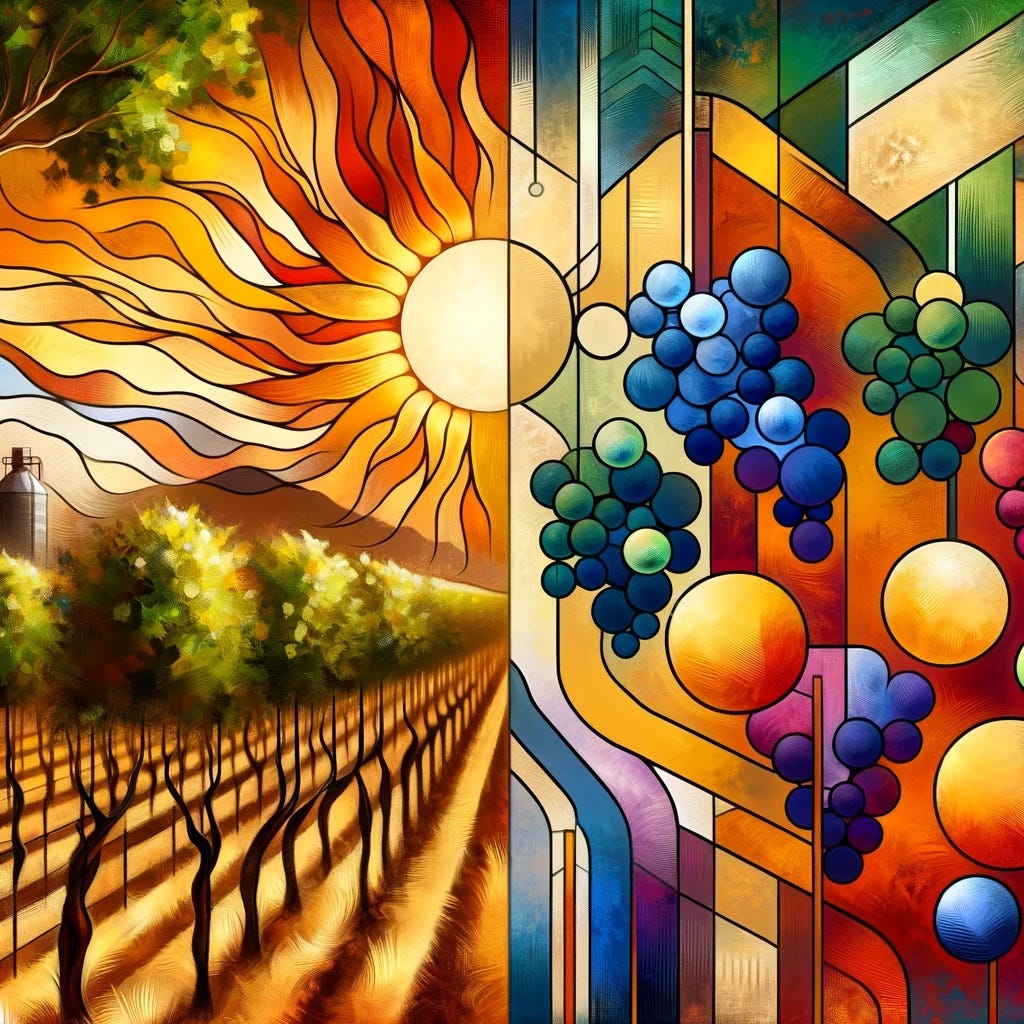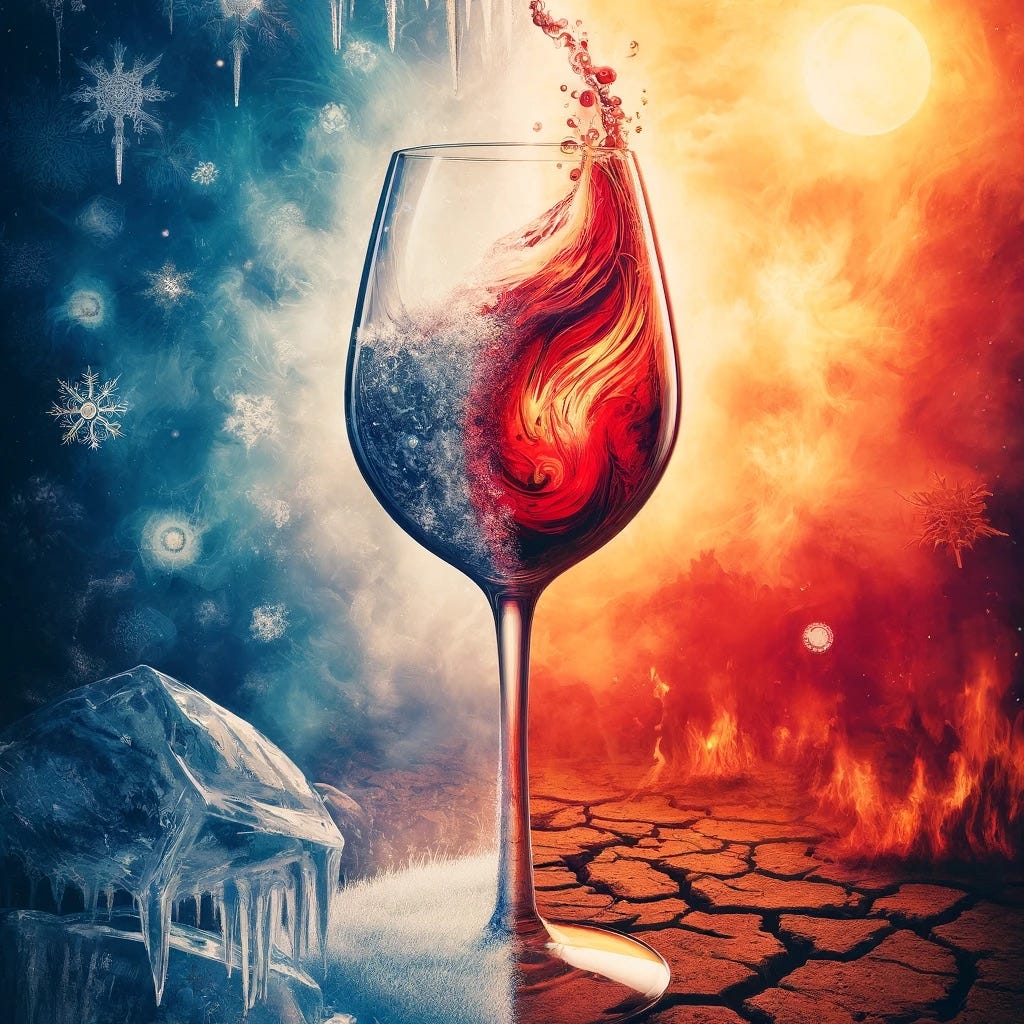NAPA VALLEY, Calif. — Global climate change foreshadows future alterations in wine styles, which has grape growers and winemakers fearful that increased temperatures may create many wines that are more alcoholic than they are now.
This could put wine sales in jeopardy because the public seems to want less alcohol in their beverages.
Many growers and wineries now are figuring out how to deal with the coming increases in temperatures and the consequent cost increases. Temperature increases portend much higher costs in terms of vineyard replanting, the addition of irrigation and misting systems and other costs associated with in-winery tactics.
For instance, there are several ways to reduce alcohol levels in wine, but most entail expensive equipment. This includes spinning cone technology, which allows for wine to be dealcoholized by passing it through a heated vacuum chamber for less than a half minute. Spinning cone advocates say wines retain natural flavors and that lower-alcohol wines can offer better flavors.
An alcohol-lowering trend that I have seen over the last two years, which is not widely evident just yet, is the conscious effort that many wineries and growers are making to lower alcohol levels in certain wines by various means. This is a response to consumer requests.
In the last several weeks, I have spoken to about a dozen industry people about this. Although the move toward lower alcohols has yet to be widely adopted, many of those I’ve spoken with agree that red wines in particular seem to have gotten to the point where they are so heavy that there is resistance in the market.
Perhaps the biggest driver toward lower alcohols is the recent “no-low” move by consumers worldwide to seek alternative beverages that have either zero alcohol or extremely low levels. This includes the abandonment of traditional wines in favor of flavored waters, teas, coffee drinks, non-alcoholic beers and several other liquids that act as temperate beverages.
Included in this group are the new zero-alcohol “high-proof” drinks that replace gin, vodka and other once high-alcohol products.
Greg La Follette, a winemaker in Sebastopol, said some of the lower alcohols he is seeing may be from some wineries trying to respond to consumers who seek less alcohol. “And there is also the natural wine movement,” he said, referring to a budding trend at making wines with less intervention, even if the final product is slightly odd. He said natural winemakers don’t fear alcohols between 11% and 12%.
David Allen, a Master of Wine, wrote about this recently in Wine-Searcher.com in his report on the annual “en-primeur”tastings in Bordeaux. These are extensive evaluations of the new (2023), still-in-barrel wines.
Allen wrote, “Personally, I have notes on more than 350 wines tasted over 11 days; I drove more than 1,600 kms, walked 42 kms, recorded more than 25 YouTube videos, and visited 65 châteaux.”
Among his observations was to call the 2023 harvest “classic.” He wrote:
“So, how are the wines classic? Firstly, many have relatively low alcohol levels. I hardly tasted any wines that were significantly above 14 percent alcohol and many were down as low as 13 percent. This probably relates to early picking of some Merlots and the use of higher proportions of the two Cabernets in blends. Acidity levels were fresh, giving many wines lovely, lifted perfumes.”
Since weather conditions in Bordeaux in 2023 were neither hot nor cold, Allen did not attribute the lower alcohols to Mother Nature, leading to the conclusion that growers generally believed the wines would be best with less alcohol.
Don Chigazola, a Santa Rosa importer of Italian wines, said that most Italian reds aren’t excessively alcoholic to begin with, but, “One thing I’ve noticed over the last year is that my wine club members seem to be switching from reds to whites, and I suspect that part of that is related to their desire to have wines with less alcohol.”
“Fifteen percent alcohol is just not the way to go for Chilean winemakers,” said Larry Challacombe, who imports wines from Chile and Argentina at Global Vineyard Importers in Berkeley. He said that several of his Chilean wineries are doing “a lot of interesting things,” such as some producers making red wines from pais (also called mission in the United States). He said this produces a pais that is an attractive, lighter-styled red wine with only 11.5% alcohol.
“Neither Argentina nor Chile had the alcohol spike we did in California,” he said, “and some producers are picking a little bit earlier for better balance. And most of our (Chilean) sauvignon blancs are doing very well in the marketplace and almost all of those are 12.5% alcohol.”
Challacombe also pointed out that most red wine vineyards in South America are planted on their own rootstocks, which may account for many of the wines having a little bit more varietal distinction.
Two New Zealand producers now offer alternative sauvignon blancs in the United States. Brancott’s Flight Song SB has only 9% alcohol. Giesen’s dealcoholized sauvignon blanc has no alcohol at all.
La Follette also said that the now moribund movement called “In Pursuit of Balance” was instigated by former San Francisco sommelier Raj Parr. The organization was based on the concept that the best wines were better balanced than were high-alcohol wines (15% range). Parr and several winemakers tried to foster the notion that excessive alcohols in wine actually masked flavors.
Unfortunately, the group lacked cohesion, and although it staged a few explanatory tasting events, organizers could never get much traction, and the association eventually collapsed. However, Parr joined forces with partners and eventually founded Evening Land Vineyards in Salem, Oregon. Most of his wines are balanced with moderate alcohol levels.
The trend toward lower alcohols in red wines may not have yet had an impact in Napa Valley cabernets. Many high-end cabernet consumers still believe that higher-alcohol cabs are better than those that are balanced with lower alcohols and pH levels.
Wine Discovery:
2019 Giesen Pinot Noir, Marlborough ($16) – New Zealand makes a wide range of excellent pinot noirs and one of the most skillful companies in this specialty is Giesen, which has several exceptional red wines in many areas of the country. One highly sought brand is Bell Hill, located on New Zealand’s South Island in the underrated district of North Canterbury. A more reasonably priced wine is this one from the northern area of Marlborough. The aroma is a Burgundian-styled combination of sour cherry, green tea and plum. The wine is tart partly because of high acidity and low alcohol (12.5%). Some people may consider this wine a bit austere because of its acidity, but I adore it with simple seafoods prepared with lemon butter.
If today’s story captured your interest, explore these related articles:
Dan Berger's wine country chronicles: The power of pronunciation
Dan Berger's Varietal Views: Delving into riesling's complex profile
Dan Berger has been writing about wine since 1975.








I opened this email when I had to savor it but it was too late to participate in the survey. I choose lower alcohol wines because I love wine and then I can have a second glass.
I prefer sub 14 wines. Our experiences abroad shaped that perspective. I love what Samuel Louis Smith is doing down in Monterey County. He learned his craft in France and produces a lot of his wines in the 12 -13% ranges. Food and brain friendly. Www.slswines.com